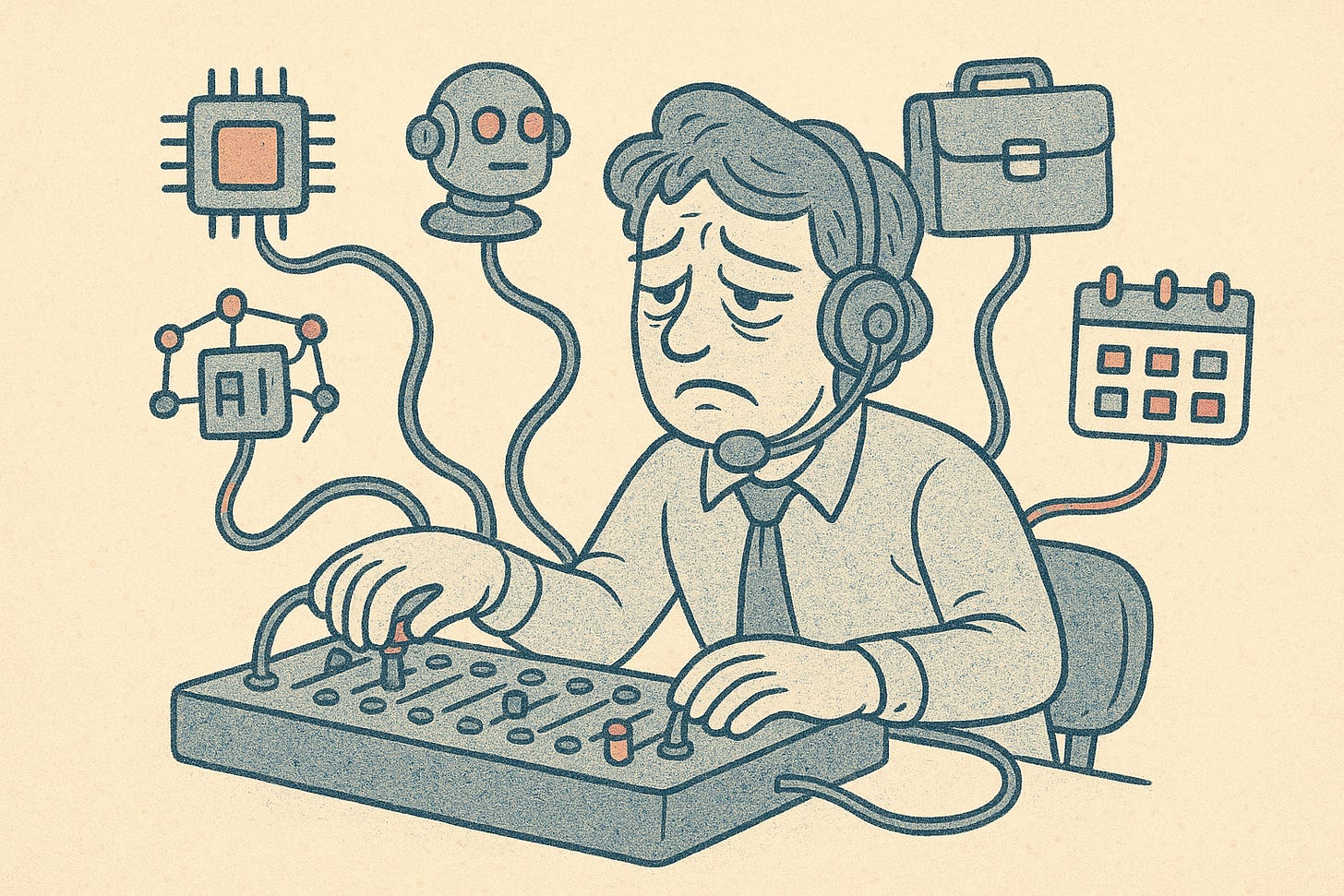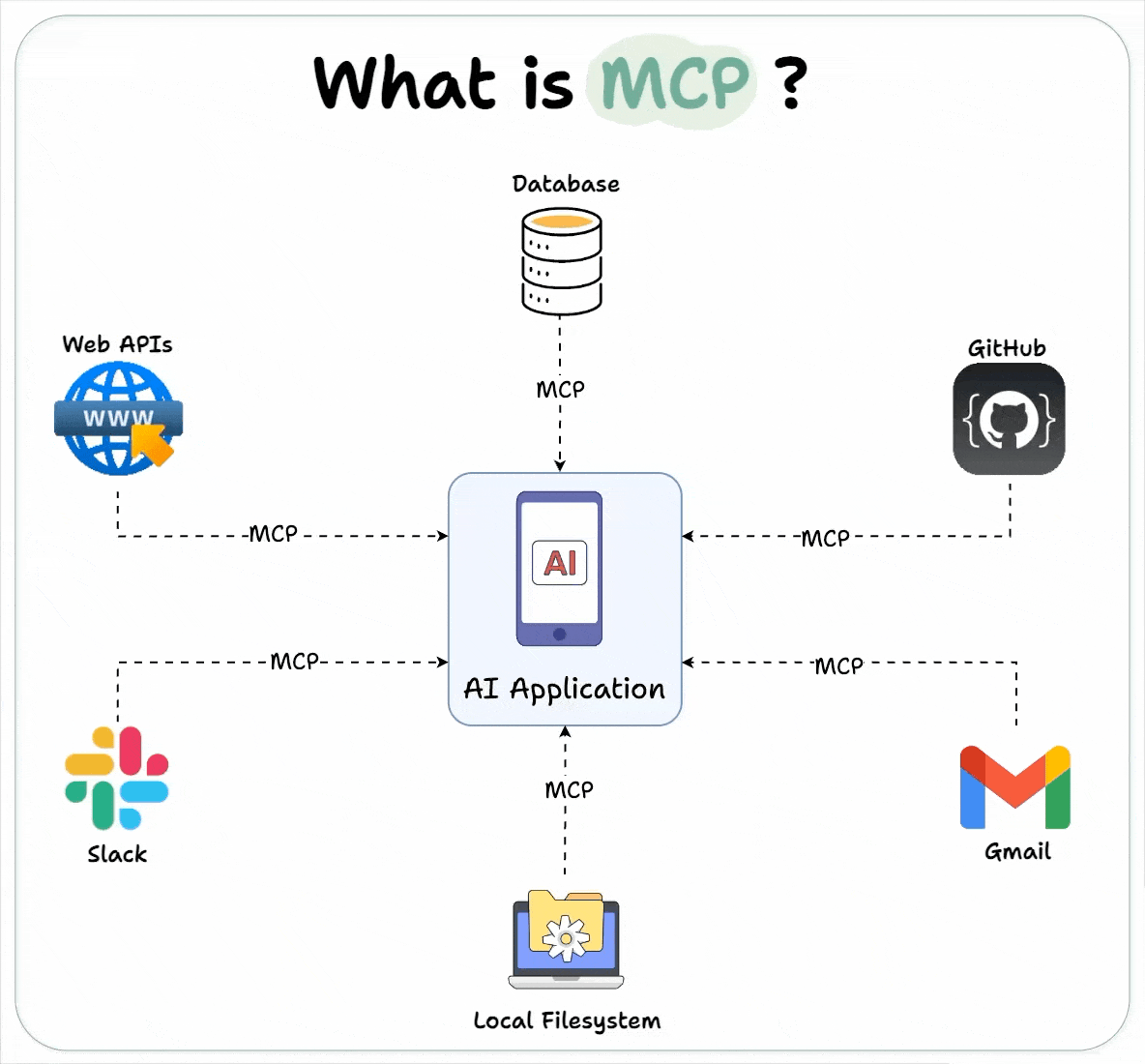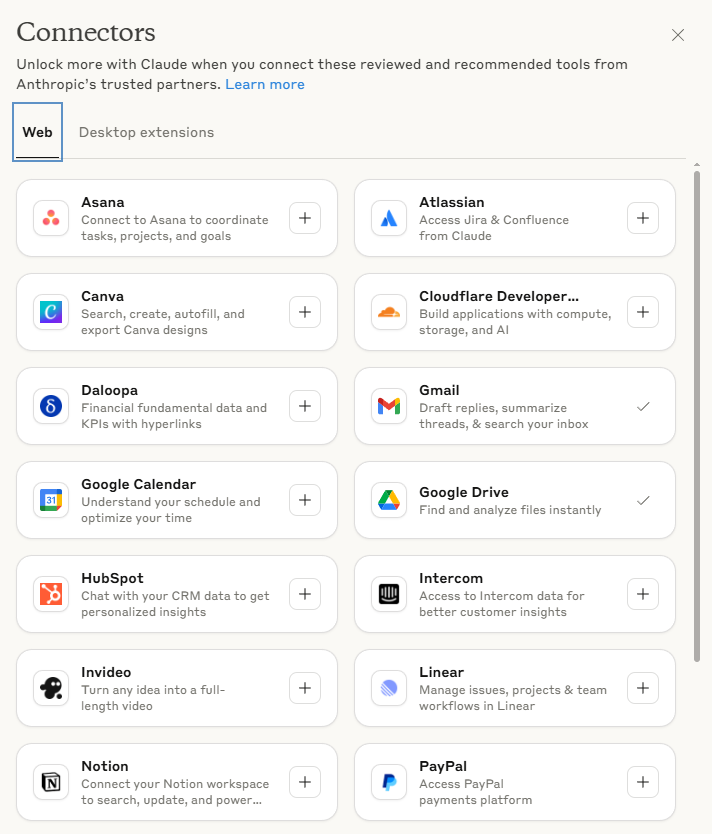Model Context Protocol: Stop Playing Messenger to Your AI
A step-by-step roadmap for solo entrepreneurs to safely connect AI to their business tools
Three weeks ago, I created a demo: automatically scheduling and publishing Substack Notes using Model Context Protocol.
The response surprised me.
The engagement was noticeably higher than my typical technical content. People were genuinely excited about technology that could connect their business tools to AI from the outside. The conversations kept circling back to the same theme: finally having AI that could work across multiple systems.
The breakthrough came when I realized why they reacted so strongly. This wasn't just about connecting tools - it was about the daily frustration every solo entrepreneur knows but rarely talks about.
Here's the embarrassing truth. Every solo entrepreneur faces the same three struggles every single day.
Your AI assistant gives you generic answers because it can't see your business context. It doesn't know your client history, current project status, or what happened in yesterday's email conversations. You ask for help, and it responds like it's meeting you for the first time.
The copy-paste dance steals 15-20 minutes per client. You manually move the same information between your email, project management tool, invoicing system, and client communication platform. What should take two minutes becomes a tedious workflow of switching tabs and duplicating data.
The impossible client question haunts your inbox: "What's the status on everything?" To answer properly, you need to check four different business apps, cross-reference project timelines, review recent communications, and somehow compile it all into a coherent update.
Sound familiar?
What if your AI could access all your business tools in one conversation?
That question - what if your AI could access all your business tools - is exactly what Model Context Protocol makes possible.
I touched on MCP in that demo, but given the strong interest, this article goes much deeper into what it actually is and how you can apply it to your business. Let's start with the basics.
What Model Context Protocol Actually Is (Without the Tech Jargon)
Model Context Protocol is a universal language that allows AI to communicate directly with your business tools. But to understand why this matters, you need to know what AI was like before.
Your AI assistant was like having a brilliant advisor locked in a soundproof room. They could think and analyze, but they couldn't see your client emails, check your project status, or update your business systems. You were the messenger - constantly carrying information TO your AI, then carrying their responses BACK to your business tools.
Need to follow up with clients? You'd manually gather client information, feed it to AI, get suggestions, then copy-paste those suggestions into your email system. Every. Single. Time.
MCP changes everything by building a communication bridge between your AI and your business systems.
Now your AI can directly read your client database, check project timelines, draft emails, and update systems - all without you playing messenger. It's like finally letting that brilliant advisor out of the soundproof room and giving them direct access to work with your business departments.
Now AI can reach outside its isolated environment and participate reliably in your business workflows. That's what makes MCP a universal language - it's specifically designed to make AI-external world communication reliable and standardized for AI models, rather than requiring human developers to build custom connections.
Understanding what MCP is only tells half the story. The real breakthrough is what becomes possible when AI can finally think its way through your business tasks.
When AI Figures Out How to Get Things Done
Remember when connecting your business apps meant calling a developer? You'd describe what you wanted, they'd disappear for weeks building custom code, and you'd get something that sort of worked but broke every time either app updated.
Now there's a different approach.
The difference is simple. Your AI can now understand what you're actually trying to accomplish, then figure out how to make it happen across whatever tools you use.
Think about this scenario that happens to every solo entrepreneur. You realize some clients have gone quiet, and you need to follow up. But which clients? What's their current project status? What was the last thing you discussed? How long has it been since they responded?
In the old world, this meant an hour of detective work. Open your email, scroll through conversations, check your project tracker, review your notes, then manually piece together personalized messages for each client.
Now? You have a conversation with your AI.
"My client communication feels stale. Can you identify who needs a follow-up and draft something appropriate for each situation?"
Your AI digs through your email threads, cross-references project timelines, analyzes communication patterns, and creates personalized outreach based on each client's unique context. Then it shows you everything for approval before sending.
The entire process moves from scattered manual work to one focused conversation. You stay in control, but the heavy lifting disappears.
This isn't about fancy technology. It's about finally having an AI that understands your business the way a great business partner would.
How to Start with MCP (Even If You're Not Technical)
Starting with MCP is simpler than most people expect. This roadmap is designed for your comfort level - everything is reversible, and you can't break anything by trying. Let's start with the simplest possible step.
Step 1: Try Your First AI Connection
What You'll Do: Test AI's ability to read your business data
Time Needed: 15 minutes
Risk Level: Zero - you're just looking, not changing anything
Here's the truth about getting started. You're probably thinking this sounds complicated. It's not.
If you're already using Claude Desktop or ChatGPT, you're closer than you think. Both have built-in connections waiting for you to try them. No downloads, no setup, no risk of breaking anything.
Your First Requests:
"Show me my emails from the past week that mention 'project deadline'"
"Find my folder called 'Client Contracts' in Google Drive"
That's it. You're not asking AI to change anything or send messages. You're just letting it look at information you already have access to.
Success Looks Like: You see actual data from your real systems - client names from your actual database, folder contents from your actual Google Drive, email subjects from conversations you actually had.
If It Doesn't Work: Disconnect and go back to normal. No harm done.
This takes about fifteen minutes. But most people don't want to go back. They want to see what else is possible.
Step 2: Connect to Your Business Tools
What You'll Do: Let AI analyze one of your daily business tools
Time Needed: 20 minutes
Risk Level: Still zero - AI can only look, never change anything
You've seen AI pull basic information from your systems. Now let's get interesting.
Pick the business tool you check most often. Your email, Google Drive, or project tracker. Just one - don't complicate things yet.
This time, ask your AI to do something smarter than finding files. Ask it to analyze patterns, spot trends, or make connections you might miss.
Your Next-Level Requests:
"Review my client emails from this month and tell me which projects seem stalled"
"Look through my Google Drive and identify which document types I create most often"
"Analyze my project deadlines and show me where I tend to fall behind"
Notice what's happening. You're not asking AI to change anything or send messages. But you're also not limiting it to simple searches anymore.
Success Looks Like: AI delivers insights about your actual business that you hadn't noticed. Patterns in your communication style. Trends in your project timelines. Connections between different clients or work types.
If Something Feels Wrong: Disconnect that tool immediately. You're in complete control of what AI can access.
The breakthrough moment happens when AI tells you something true about your business that surprises you. Something you could verify if you spent hours digging through data yourself.
That's when you realize what business partnership with AI actually means.
Step 3: Let AI Do Simple Tasks
What You'll Do: Allow AI to perform one small action with your permission
Time Needed: 30 minutes
Risk Level: Low - you approve every action before it happens
Now comes the moment most people worry about. Letting AI actually do something instead of just looking.
Here's the secret: you're still completely in charge.
Your AI won't take any action without asking first. Every time it wants to send an email, update a file, or change anything, you get to decide. "Allow Once" or "Always Allow" for this type of task. Start with "Allow Once" until you feel comfortable.
Think of a task that normally takes you twenty minutes of jumping between tools. Following up with a client who's gone quiet is perfect for this.
Your First Action Request: "Find my conversation with [Client Name], understand where we left off, and draft a personalized follow-up email for me to review."
Watch what happens. AI searches your email history, reads the conversation context, understands the project status, and creates a follow-up that references specific details from your actual conversation.
Then it stops and asks: "Should I save this draft to your email?"
Success Looks Like: AI presents work that would have taken you significant manual effort - a thoughtful email that shows it understood your conversation history and business context.
If You Don't Like What It Created: Say no. Try a different approach. Delete the draft. You're in complete control of what actually gets saved or sent.
The magic isn't just that AI completed the task. It's that AI did the tedious research and synthesis work, leaving you to focus on the final decision and refinement.
This is what business partnership feels like.
Step 4: Build Your Personal AI Assistant
By now, you've seen AI understand your business and complete time-consuming tasks.
Start with your biggest pain point. What repetitive task drives you crazy each week? That frustration is your roadmap.
Add one new connection at a time. Test thoroughly before expanding.
The goal isn't connecting every tool. It's building a reliable system that handles energy-draining work so you can focus on growing your business.
You've succeeded when checking your AI becomes as natural as checking email, and complex tasks feel simple because AI handles the coordination.
Your MCP Connection Strategy
Here's what most people assume when they hear about MCP: they need to hunt down custom servers, learn technical setups, and figure out complex configurations before they can start.
That's not true.
If you're using Claude Desktop or ChatGPT, you already have MCP connectors built in. No downloads, no configuration files, no GitHub repositories to navigate.
These aren't "beginner" connectors you'll outgrow. They're professionally maintained by the teams at Anthropic and OpenAI. They're tested, stable, and updated regularly.
Starting here makes sense for three reasons:
You can test MCP concepts without any technical risk
You learn how AI-tool connections actually work in practice
You build confidence before exploring more complex options
The community has created thousands of additional MCP servers for specialized tools and services. You can find comprehensive lists on GitHub when you're ready to expand.
Security matters when exploring community options. Review exactly what permissions each server requests and what business data it can access. Always examine what you're allowing before granting access.
Choose servers from trusted sources with strong security practices, good documentation, and active maintenance.
Start with what you already have. Master the basics. Then expand thoughtfully when you identify specific gaps in your workflow.
The tools you need are already waiting for you.
Ready to Get Started?
You have everything you need to start right now. Pick one tool, try the first step, and see what happens when your AI finally understands your business. Subscribe for more practical AI guides that eliminate busy work from your day.






For the record, I have a chatGPT plus account and connectors are not available yet. I even went as far as asking gpt directly when I couldn't find them. It informed me that it's enterprise level only at the moment
Luan, this is exactly the kind of practical breakdown more people need in the AI space.
I really appreciated how you focused on solving actual day-to-day friction. The copy-paste relay is all too familiar... every solo entrepreneur has been there.
And your step-by-step approach was thoughtful. Starting with “just look, don’t change anything” is where a lot of technical content might gloss over which can cause confusion and overwhelm before they even start.
Keep sharing guides like this. Making AI feel useful and manageable is what helps moves things forward!